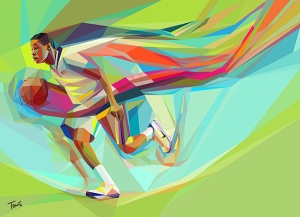The next area for investigation was the current use of geometry within graphic design. In order to ensure my work remains current and relevant it is important to compare it to the work of others in my field.
Recently many designers are taking a geometric based approach, and thanks to available vector-based software fully scalable geometric based work can be created.
The following examples utilise a range of techniques incorporating geometry within their pieces.
Diego Bellorin with the Virtual Chaos and Escapulario projects uses simple geometric forms to create abstract worlds. These pieces are of interest to me as they show such seemingly complex work can be formed from the simplest geometric forms. I am interested in exploring the messages that can be conveyed using these simple building blocks of geometry. I would be interested to know the intention of the artist when creating these pieces, as little description is available, and it is always advantageous to compare the working process of others to that of yourself.
Bellorin, D., 2011. Virtual Chaos. [electronic print] Available at: <http://www.behance.net/gallery/Virtual-Chaos/925898> %5BAccessed 3rd December 2011].
Bellorin, D., 2011. Escapulario. [electronic print] Available at: <http://www.behance.net/gallery/Escapulario/954638> %5BAccessed 3rd December 2011].
Charis Tsevis meanwhile, explores the use of breaking an image down into its geometric roots, stemming from cubism and futurism, this is an alternative approach to geometry within graphic design. I find it important to consider a variety of different styles relating to my chosen subject area, although within my initial investigations I discussed the possibility of forming a larger piece from a variety of components, it is advantageous not to restrict ones research so greatly at such an early stage of the project. This ensures I will follow the most suitable path for my body of work.
Tsevis, C., 2010. Turkey 2010 Basketball Championship Illustration. [electronic print] Available at: <http://www.behance.net/gallery/Turkey-2010-Basketball-World-Championship/688187> [Accessed 3rd December 2011].
Following a visit to the Science Museum, London, I considered the recently redesigned geometric based logo.
Banks, J., 2009. Science Museum. [electronic print] Available at: <http://editorial.designtaxi.com/news-newscience/1.jpg> %5BAccessed 3rd December 2011].
Released in 2009 by Johnson Banks, following a commission to increase the attraction for visitors, the designers attempted to form an identity for the Museum which would convey the message of its exhibitions.The logo incorporates a geometric grid and simple geometric forms, aiming to convey the message that science require decoding and understanding.1 Further information relating to the formation of the logo and branding design can be found at the Johnson Banks website – http://www.johnsonbanks.co.uk/thoughtfortheweek/index.php?thoughtid=583
The work of Johnson Banks relating to the Science Museum was an interesting avenue of investigation for me, it allowed exploration into the manner in which other designers tackle problems of conveying a message in a simple manner and retaining (and gaining) public interest.
Another example of a use of geometry within design is an architectural one; The Kirkcaldy Maggies Centre by Architect Zaha Hadid.
Hadid, Z., n.d. Maggies Centre Kirkcaldy. [electronic print] Available at: <http://scmhardsoft.altervista.org/wp-content/uploads/2010/11/Maggies_Centre_Fife_by_Zaha_Hadi-16.jpg> [Accessed 3rd December 2011].

Anon, n.d. Maggies Centre Kirkcaldy. [electronic print] Available at: <http://my.opera.com/POM032002/albums/showpic.dml?album=210943&picture=3178933> [Accessed 3rd December 2011].
Her buildings, including the above example, often utilise geometric forms both within the plan and 3D form. However Hadid has faced criticism as they often fail to contain their geometric forms for a specific purpose and are only utilised at their aesthetic value.
Here I have investigated two alternative uses of geometry, that for purpose within the Science Museum, and that for aesthetic value.
This contradiction; using geometry to enhance a message or purely for aesthetic purposes is intended to be explored within the project. I believe geometry should not be used as ornamentation, I believe I follow many of the modernist principles, that every part of the design should play a purpose.
—
1. Banks, J., 2010. Science Museum. [online] Available at: <http://www.johnsonbanks.co.uk/identity-and-branding/cultural/science-museum/> [Accessed 3rd December 2011].




